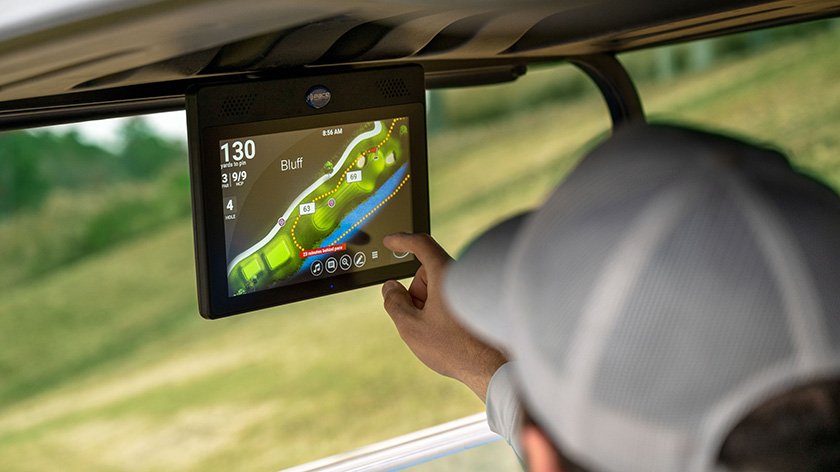Smart LCD Displays: The Modern Dashboard
Golf car displays have evolved into high-resolution, sunlight-readable LCD or LED panels powered by integrated microprocessors. These smart LCD interfaces serve as centralized information hubs, combining real-time vehicle data, navigation, entertainment, and safety features in one intuitive touchscreen system.
Key functionalities include:
- Battery status, speed, motor temperature, and range monitoring
- Capacitive touch navigation, styled like a tablet interface
- Customizable UI branding and dashboard layouts tailored to the golf course or vehicle operator
- GPS-based alerts, diagnostics, and over-the-air updates for long-term maintenance and feature enhancements
Performance Monitoring & Real-Time Feedback
Golf car displays empower drivers with instant metrics:
- Speed, battery level, and estimated remaining range
- Motor diagnostics and temperature alerts
- Ability to monitor energy usage trends and prevent mid-course failures
nuolecart.comcdtech-lcd.com
This visibility supports smarter driving decisions and proactive maintenance—minimizing downtime and extending equipment lifespan.
GPS Navigation, Alerts & Pace Management
Full-featured LCD displays often include:
- Interactive GPS mapping and course layouts
- Yardages to hazards, greens, and pin placements
- Geofencing alerts to guide carts away from restricted zones
- Pace-of-play alerts to maintain game flow
- Push notifications, delivered at specific course locations
Tagmarshal’s 2Way system, for instance, enables location-triggered reminders like parking prompts and hazard warnings.
Users confirm that GPS displays eliminate the need for personal rangefinders by providing accurate shot yardage directly on-screen.
Entertainment & Connectivity
Modern golf car displays now integrate Bluetooth, Wi-Fi, and media players, transforming carts into mobile entertainment hubs.
- Drivers can stream music, make hands-free calls, and play media from smartphones
- Bluetooth speakers effectively deliver sound with minimal disturbances
This blend of entertainment and control enhances the overall ride experience without clutter.
Enhanced Safety and Control
Displays also elevate safety features:
- Reverse camera feeds and proximity alerts reduce accident risk
- Interactive dashboards reduce cognitive load by centralizing controls and displaying only essential info
- Geofencing and speed limits, tied into the display and cart systems, enforce safety rules automatically
Club Car’s Visage platform enables remote fleet control, locking/unlocking vehicles, adjusting speed limits, and preventing movement in restricted zones—all managed via the display interface.
clubcar.com
Customization & Branding
Digital displays offer visual flexibility:
- Custom UI colors, brand logos, and layouts create consistent identity
- Customizable dashboards enable venue-specific functionality (e.g. resort promotions, map overlays)
- Fleet-level display templates simplify deployment across multiple carts
This adaptability benefits course operators, resorts, and event coordinators aiming for polished, branded experiences.
Improved Operational Efficiency
Fleet managers benefit from:
- Real-time tracking and diagnostics via display-connected backend systems
- Battery health monitoring and usage logging for preventative maintenance
- Automated alerts when carts deviate off path or enter hazard zones
Such systems streamline logistics and reduce maintenance costs dramatically.
Performance Impact: What the Research Says
- Touchscreen LCDs are easier to read in bright sunlight due to HD resolution and anti-glare designs—still legible where analog gauges struggle.
- Users report that integrated GPS screens dramatically improve pace-of-play and navigation confidence.
- Rides with touchscreen control reduce distractions compared to physical knobs—drivers can toggle functions on-screen without removing eyes from the course.
Use Case Examples
Golf Courses & Resorts
Screens deliver course maps, scores, weather alerts, and promotional banners directly on the cart dashboard. High-value venues leverage displays to boost engagement and service efficiency.
Community and Residential Transport
Electric golf carts used in gated communities or campuses benefit from displays featuring navigation, lighting controls, and alerts.
Security & Patrol Vehicles
Smart displays enable real-time communication, route mapping, incident logging, and camera feeds—turning simple carts into mobile security units.
Design Considerations & Trade-offs
Pros
- Cleaner interface—reduces clutter and simplifies operation
- Immediate visual feedback for performance, navigation, and safety
- Upgradeable via OTA updates, extending hardware life
- Future-proof integration with new features or sensors
Cons
- Cost—touchscreen modules cost more than analog gauges
- Fragility—screen breakage or waterproofing failures impact functionality
- Tactile feedback loss—some users prefer physical buttons over glass surfaces
- Potential input errors if display calibration is poor or terrain is rough
Best Practices for Implementation
To maximize benefits, follow these guidelines:
- Use sunlight-readable, anti-glare, high-brightness displays for outdoor use
- Choose IP-rated enclosures and rugged glass for durability
- Design UI for use with gloves and bumpy terrain to prevent mispresses
- Include redundant safety features (e.g. physical cut-off buttons) if touchscreen fails
- Enable OTA updates for UI, map data, and diagnostic enhancements
- Implement real-time maintenance alerts and fleet refurbishment scheduling
Frequently Asked Questions
Q1: Can golf car displays really improve pace-of-play?
Yes. GPS and course mapping systems help golfers understand distances and avoid delays; alerts help maintain tempo.
Q2: Do these displays hold up outdoors?
Modern units are designed with high-brightness screens and rugged housing. They remain visible even under bright sun, unlike older analog gauges.
Q3: Is battery life a concern with LCD screens?
Displays powered by vehicle batteries consume minimal energy relative to motor load. Optimized power management keeps them efficient during a round or shift.
Q4: What about glare and readability?
Anti-glare screens and high-brightness rendering ensure clarity in sunlight and ensure safety.
Q5: Can I customize the interface?
Yes—most vendors support branded UI, custom layouts, and personalized function sets based on fleet or venue demands.
Conclusion
Smart LCD displays have revolutionized golf car functionality—bringing navigation, diagnostics, entertainment, and safety features into a vibrant touchscreen experience. They simplify operations for fleet managers and elevate the ride quality for users. While analog dashboards have their advantages in simplicity and price, modern smart displays deliver unmatched flexibility, visibility, and user engagement.
Whether you’re managing a resort fleet, developing custom fleet interfaces, or upgrading community transport, investing in high-quality golf car displays adds measurable performance and tangible operational benefits.
Let me know if you’d like spec comparison tables or UI mock-ups tailored to your project needs!
